The Steel Studs Market is estimated to be valued at USD 10.6 billion in 2025 and is projected to reach USD 16.0 billion by 2035, registering a compound annual growth rate (CAGR) of 4.2% over the forecast period. Between 2025 and 2030, the market is expected to rise from USD 10.6 billion to USD 13.1 billion, driven by increasing demand in the construction industry, particularly in residential and commercial building projects.
Year-on-year analysis shows steady growth, with values reaching USD 11.1 billion in 2026 and USD 11.5 billion in 2027, supported by advancements in construction techniques and the shift toward steel-framed structures. By 2028, the market is forecasted to hit USD 12.0 billion, advancing to USD 12.5 billion in 2029 and USD 13.1 billion by 2030.
Growth is expected to be further fueled by the rising popularity of steel studs as an alternative to traditional wooden studs, offering enhanced durability, fire resistance, and lower maintenance. These dynamics position the steel studs market as a key component in modern construction, with substantial opportunities for expansion as urbanization and infrastructure development continue globally.
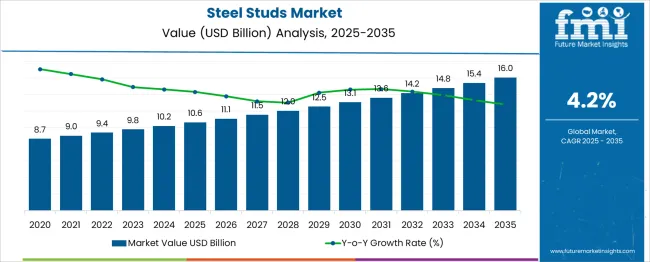
| Metric | Value |
|---|---|
| Steel Studs Market Estimated Value in (2025 E) | USD 10.6 billion |
| Steel Studs Market Forecast Value in (2035 F) | USD 16.0 billion |
| Forecast CAGR (2025 to 2035) | 4.2% |
The Steel Studs market is experiencing notable growth supported by increasing demand for durable and fire-resistant building materials in construction projects. The current scenario reflects a shift toward sustainable and recyclable alternatives to traditional wood framing, as highlighted in corporate disclosures and construction industry news.
Growth is being reinforced by rising investments in urban infrastructure, stricter building codes, and a growing emphasis on green building certifications. Future prospects appear strong as innovations in manufacturing processes improve cost efficiency and performance of steel studs while reducing their environmental impact.
Investor presentations and trade journals have also reported that the adoption of steel studs is gaining momentum due to their resistance to pests, moisture, and warping which ensures structural integrity over longer periods. With continued urbanization and heightened awareness of construction safety standards, the market is anticipated to expand steadily with opportunities emerging across residential, commercial, and institutional projects globally.
The steel studs market is segmented by type, finish type, application, and geographic regions. The steel studs market is divided into Load-bearing steel studs, non-load-bearing steel studs, Structural steel studs, Curtain wall steel studs, and Others. In terms of finish type, the steel studs market is classified into Galvanized steel studs, Galvalume steel studs, Bare steel studs, and Others.
Based on the application, the steel studs market is segmented into Commercial construction, Residential construction, Industrial construction, Infrastructure projects, Renovation and remodeling, and Prefabricated and modular construction. Regionally, the steel studs industry is classified into North America, Latin America, Western Europe, Eastern Europe, Balkan & Baltic Countries, Russia & Belarus, Central Asia, East Asia, South Asia & Pacific, and the Middle East & Africa.
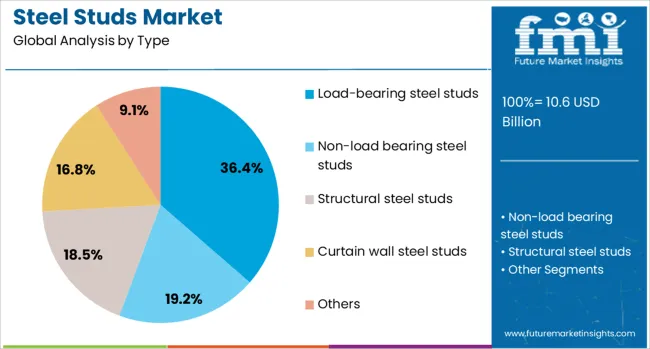
The load-bearing steel studs type is projected to hold 36.4% of the Steel Studs market revenue share in 2025, establishing it as the leading type segment. This leadership is being attributed to their ability to provide superior structural support in multi-story buildings as noted in product technical sheets and builder specifications.
The segment’s prominence has been driven by its strength-to-weight ratio, which facilitates the construction of taller and more resilient structures while meeting seismic and wind load requirements. Trade publications have highlighted that developers prefer load-bearing steel studs for their predictable performance and compliance with stringent safety regulations.
Additionally, the use of these studs enables efficient integration with modern construction techniques such as prefabrication, which reduces overall project timelines. Maintenance advantages and long-term durability have also contributed to the preference for load-bearing steel studs, ensuring their continued dominance in the market.
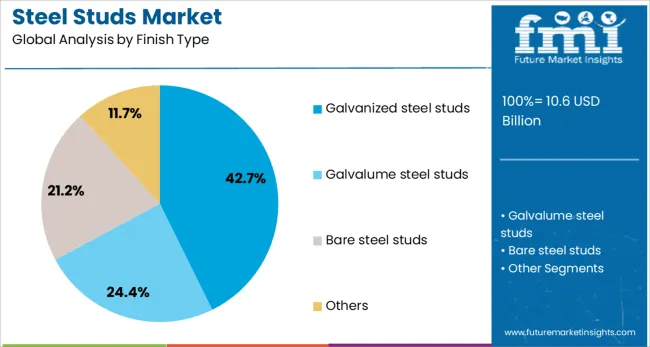
The galvanized steel studs finish type is expected to account for 42.7% of the Steel Studs market revenue share in 2025, making it the largest finish type segment. This leadership is being reinforced by their superior resistance to corrosion and moisture, which enhances their lifespan and reliability, particularly in humid and coastal environments.
Construction industry sources have observed that galvanized finishes meet evolving building codes focused on sustainability and durability while reducing long-term maintenance costs. Investor reports have also noted that galvanized steel studs are being increasingly adopted in projects prioritizing low lifecycle costs and environmental compliance.
The widespread availability of galvanized variants and their compatibility with diverse architectural designs have further bolstered their acceptance in both residential and commercial projects. These benefits together have maintained the segment’s leading position in the market.
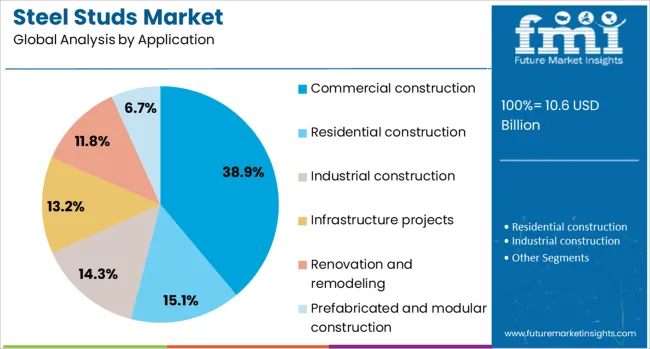
The commercial construction application segment is forecasted to command 38.9% of the Steel Studs market revenue share in 2025, maintaining its position as the largest application segment. This dominance has been supported by the substantial demand from office buildings, hotels, retail spaces, and healthcare facilities, as reported in corporate strategy presentations and construction industry news.
Commercial developers have preferred steel studs for their scalability, fire resistance, and ability to support complex architectural requirements while complying with regulatory standards. Trade journals have emphasized that steel studs contribute to faster project completion and offer cost efficiencies that align with the financial goals of commercial property owners.
Their adaptability to advanced construction methods, such as modular building, and their alignment with green building initiatives have further solidified their relevance. These factors have collectively ensured the commercial construction segment’s sustained leadership in the Steel Studs market in 2025.
The steel studs market is driven by growing demand for durable, lightweight construction materials in residential and commercial sectors. Opportunities are expanding in new and renovation projects, while trends toward eco-friendly coatings are reshaping the market. However, challenges such as high material costs and limited steel availability remain. By 2025, overcoming these obstacles with cost-effective solutions and efficient sourcing will be crucial for continued market growth.
The steel studs market is expanding due to the increasing demand for durable and lightweight building materials in construction. Steel studs offer superior strength, fire resistance, and long-lasting performance compared to traditional wood studs. As construction projects scale and the need for efficient, cost-effective materials grows, steel studs are becoming a preferred choice. By 2025, the market is expected to continue benefiting from this increasing preference for materials that combine strength with flexibility, particularly in commercial and residential construction.
Opportunities in the steel studs market are growing with the expansion of residential and commercial construction projects. Steel studs are increasingly used in framing for walls and ceilings due to their strength, lightweight properties, and resistance to moisture and pests. The rise in commercial and residential construction, especially in developing regions, offers substantial growth potential for steel stud manufacturers. By 2025, the market will likely experience significant opportunities in both new builds and renovation projects, driving further demand for steel studs.
Emerging trends in the steel studs market show a growing shift toward steel studs with eco-friendly coatings. As construction moves toward more environmentally friendly solutions, steel studs coated with non-toxic, corrosion-resistant, and environmentally safe materials are becoming more popular. These advancements ensure longer-lasting products and reduce maintenance requirements. By 2025, the market is expected to see more widespread adoption of steel studs with eco-friendly coatings, especially as building codes become stricter regarding environmental impact.
Despite growth, challenges related to high material costs and limited availability of raw materials persist in the steel studs market. The production of steel studs requires high-quality steel, which can be costly, especially with fluctuating steel prices. Additionally, supply chain disruptions or shortages in steel production can delay manufacturing timelines. These factors may hinder the adoption of steel studs in cost-sensitive markets. By 2025, addressing these challenges through more efficient production and sourcing strategies will be key to market growth.
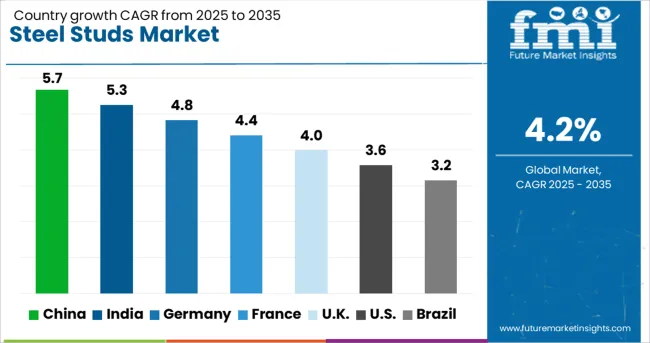
| Country | CAGR |
|---|---|
| China | 5.7% |
| India | 5.3% |
| Germany | 4.8% |
| France | 4.4% |
| UK | 4.0% |
| USA | 3.6% |
| Brazil | 3.2% |
The global steel studs market is projected to grow at a 4.2% CAGR from 2025 to 2035. China leads with a growth rate of 5.7%, followed by India at 5.3%, and Germany at 4.8%. The United Kingdom records a growth rate of 4.0%, while the United States shows the slowest growth at 3.6%. These differences in growth rates are driven by factors such as rising demand for construction materials, increased building activity, and the growing preference for durable, cost-effective solutions in the building and construction sectors. Emerging markets like China and India are experiencing higher growth due to rapid urbanization, infrastructure development, and demand for sustainable construction materials, while more mature markets like the USA and the UK experience steady growth due to established demand and regulatory frameworks. This report includes insights on 40+ countries; the top markets are shown here for reference.
The steel studs market in China is growing at a strong pace, with a projected CAGR of 5.7%. China’s rapidly expanding construction and infrastructure sectors are major drivers of demand for steel studs, which are widely used in residential, commercial, and industrial building projects. The country’s increasing focus on urbanization, coupled with a growing preference for durable, lightweight, and cost-effective building materials, further contributes to the growth of the market. Additionally, China’s emphasis on sustainable construction and eco-friendly building materials boosts the demand for steel studs as part of green building practices and energy-efficient designs.
The steel studs market in India is projected to grow at a CAGR of 5.3%. India’s booming construction industry, spurred by urbanization, infrastructure development, and a growing middle class, is driving the demand for steel studs. The country’s increasing investments in housing, commercial spaces, and industrial construction are further fueling market expansion. Additionally, the adoption of modern building technologies, as well as government initiatives to support infrastructure growth, is contributing to the increased demand for steel studs as part of cost-effective, durable, and energy-efficient building solutions.
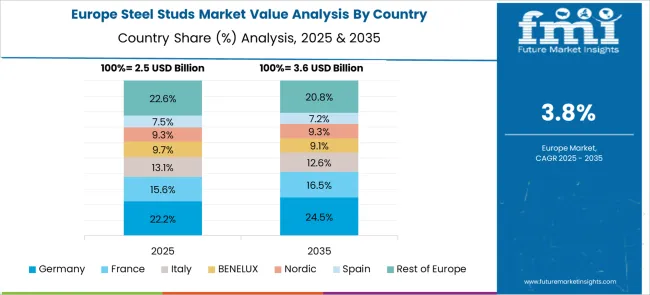
The steel studs market in Germany is projected to grow at a CAGR of 4.8%. Germany’s strong construction industry, combined with a focus on high-quality building materials, is supporting steady demand for steel studs in both residential and commercial projects. The country’s growing emphasis on sustainable and energy-efficient building solutions is further boosting the adoption of steel studs, which offer durability and flexibility. Additionally, Germany’s stringent construction standards and regulations, which emphasize material strength and safety, continue to drive demand for steel studs in both new builds and renovation projects.
The steel studs market in the United Kingdom is projected to grow at a CAGR of 4.0%. The UK has a well-established construction industry, and the demand for steel studs is driven by the growing need for strong, cost-effective, and sustainable building materials. As the country continues to focus on energy-efficient and eco-friendly construction practices, steel studs are gaining traction due to their lightweight properties and versatility. Additionally, the UK’s ongoing housing and infrastructure projects, as well as the increasing use of steel studs in industrial applications, support steady market growth.
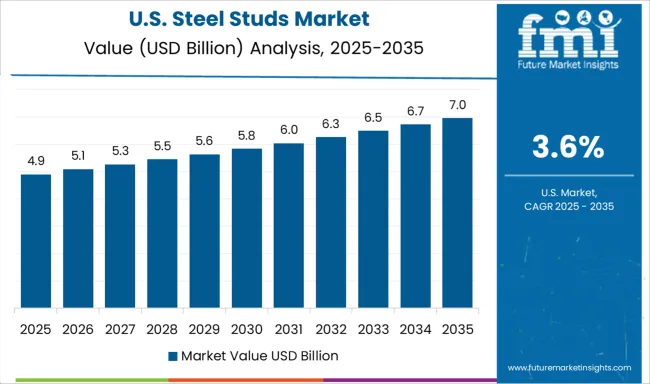
The steel studs market in the United States is expected to grow at a CAGR of 3.6%. The USA construction industry continues to drive steady demand for steel studs, with applications across residential, commercial, and industrial sectors. The increasing focus on sustainability and energy-efficient building practices, as well as the growing trend of using lightweight and durable materials, supports continued demand for steel studs. However, the growth in the USA is slower compared to emerging markets due to market maturity and the widespread adoption of steel studs in existing construction projects.
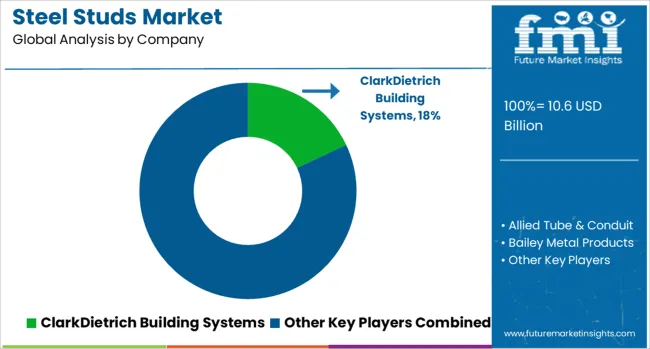
The steel studs market is dominated by ClarkDietrich Building Systems, which leads with its wide range of high-quality steel framing solutions used in residential, commercial, and industrial construction. ClarkDietrich’s dominance is supported by its strong reputation for producing durable, versatile, and cost-effective steel studs, along with its robust distribution network.
Key players such as Allied Tube & Conduit, Bailey Metal Products, and CEMCO maintain significant market shares by offering high-performance steel framing systems that ensure structural integrity and design flexibility in various building applications. These companies focus on delivering reliable products that meet industry standards and support efficient, sustainable construction practices.
Emerging players like Dietrich Metal Framing, Europrofil, and FRAMECAD are expanding their market presence by offering specialized steel stud solutions for niche applications such as modular and prefabricated construction. Their strategies include enhancing product customization, improving material strength, and offering faster, cost-effective building solutions.
Market growth is driven by increasing demand for lightweight, strong, and durable construction materials, the rise of sustainable building practices, and the expanding use of steel studs in non-residential and high-rise buildings. Innovations in galvanized steel, fire-resistant coatings, and automated framing systems are expected to shape competitive dynamics and drive further growth in the global steel studs market.
| Item | Value |
|---|---|
| Quantitative Units | USD 10.6 Billion |
| Type | Load-bearing steel studs, Non-load bearing steel studs, Structural steel studs, Curtain wall steel studs, and Others |
| Finish Type | Galvanized steel studs, Galvalume steel studs, Bare steel studs, and Others |
| Application | Commercial construction, Residential construction, Industrial construction, Infrastructure projects, Renovation and remodeling, and Prefabricated and modular construction |
| Regions Covered | North America, Europe, Asia-Pacific, Latin America, Middle East & Africa |
| Country Covered | United States, Canada, Germany, France, United Kingdom, China, Japan, India, Brazil, South Africa |
| Key Companies Profiled | ClarkDietrich Building Systems, Allied Tube & Conduit, Bailey Metal Products, CEMBRIT, CEMCO, Dietrich Metal Framing, Europrofil, FRAMECAD, FrameMax, JFE Steel Corporation, Knauf Metal, Marino WARE, MBA Building Supplies, Metsec, Nucor Corporation, O’Donnell Metal Deck, SCAFCO Steel Stud Company, Studco Building Systems, Super Stud Building Products, and The Steel Network (TSN) |
| Additional Attributes | Dollar sales by stud type and application, demand dynamics across construction, automotive, and manufacturing sectors, regional trends in steel stud adoption, innovation in lightweight and high-strength materials, impact of regulatory standards on safety and durability, and emerging use cases in green building and modular construction systems. |
The global steel studs market is estimated to be valued at USD 10.6 billion in 2025.
The market size for the steel studs market is projected to reach USD 16.0 billion by 2035.
The steel studs market is expected to grow at a 4.2% CAGR between 2025 and 2035.
The key product types in steel studs market are load-bearing steel studs, non-load bearing steel studs, structural steel studs, curtain wall steel studs and others.
In terms of finish type, galvanized steel studs segment to command 42.7% share in the steel studs market in 2025.






Our Research Products

The "Full Research Suite" delivers actionable market intel, deep dives on markets or technologies, so clients act faster, cut risk, and unlock growth.

The Leaderboard benchmarks and ranks top vendors, classifying them as Established Leaders, Leading Challengers, or Disruptors & Challengers.

Locates where complements amplify value and substitutes erode it, forecasting net impact by horizon

We deliver granular, decision-grade intel: market sizing, 5-year forecasts, pricing, adoption, usage, revenue, and operational KPIs—plus competitor tracking, regulation, and value chains—across 60 countries broadly.

Spot the shifts before they hit your P&L. We track inflection points, adoption curves, pricing moves, and ecosystem plays to show where demand is heading, why it is changing, and what to do next across high-growth markets and disruptive tech

Real-time reads of user behavior. We track shifting priorities, perceptions of today’s and next-gen services, and provider experience, then pace how fast tech moves from trial to adoption, blending buyer, consumer, and channel inputs with social signals (#WhySwitch, #UX).

Partner with our analyst team to build a custom report designed around your business priorities. From analysing market trends to assessing competitors or crafting bespoke datasets, we tailor insights to your needs.
Supplier Intelligence
Discovery & Profiling
Capacity & Footprint
Performance & Risk
Compliance & Governance
Commercial Readiness
Who Supplies Whom
Scorecards & Shortlists
Playbooks & Docs
Category Intelligence
Definition & Scope
Demand & Use Cases
Cost Drivers
Market Structure
Supply Chain Map
Trade & Policy
Operating Norms
Deliverables
Buyer Intelligence
Account Basics
Spend & Scope
Procurement Model
Vendor Requirements
Terms & Policies
Entry Strategy
Pain Points & Triggers
Outputs
Pricing Analysis
Benchmarks
Trends
Should-Cost
Indexation
Landed Cost
Commercial Terms
Deliverables
Brand Analysis
Positioning & Value Prop
Share & Presence
Customer Evidence
Go-to-Market
Digital & Reputation
Compliance & Trust
KPIs & Gaps
Outputs
Full Research Suite comprises of:
Market outlook & trends analysis
Interviews & case studies
Strategic recommendations
Vendor profiles & capabilities analysis
5-year forecasts
8 regions and 60+ country-level data splits
Market segment data splits
12 months of continuous data updates
DELIVERED AS:
PDF EXCEL ONLINE
Steel Drum Market Size and Share Forecast Outlook 2025 to 2035
Steel Drums & IBCs Market Size and Share Forecast Outlook 2025 to 2035
Steel Roll-on Tube Market Size and Share Forecast Outlook 2025 to 2035
Steel Testing Equipment Market Size and Share Forecast Outlook 2025 to 2035
Steel Salvage Drums Market Size and Share Forecast Outlook 2025 to 2035
Steel Wire Reinforced Polyethylene Pipe Market Size and Share Forecast Outlook 2025 to 2035
Steel Wire Market Size and Share Forecast Outlook 2025 to 2035
Steel Strapping Market Size and Share Forecast Outlook 2025 to 2035
Steel Drum Industry Analysis in Southeast Asia Size and Share Forecast Outlook 2025 to 2035
Steel Rebar Market Size and Share Forecast Outlook 2025 to 2035
Steel Sections Market Analysis - Size, Share, and Forecast Outlook 2025 to 2035
Steel Market Size, Growth, and Forecast 2025 to 2035
Steel Containers Market Analysis by Product Type, Capacity Type, End Use, and Region through 2025 to 2035
Steel Pipe Market Growth - Trends & Forecast 2025 to 2035
Key Players & Market Share in the Steel Containers Industry
Examining Market Share Trends in Steel Drums and IBCs Industry
Competitive Overview of Steel Drum Market Share
Western Europe Steel Drum Market Insights – Trends & Forecast 2023-2033
Korea Steel Drum Market Growth – Trends & Forecast 2023-2033
Japan Steel Drum Market Analysis – Trends & Forecast 2023-2033

Thank you!
You will receive an email from our Business Development Manager. Please be sure to check your SPAM/JUNK folder too.
Chat With
MaRIA